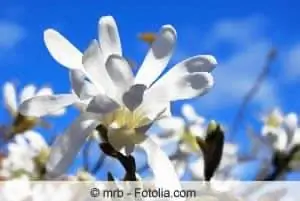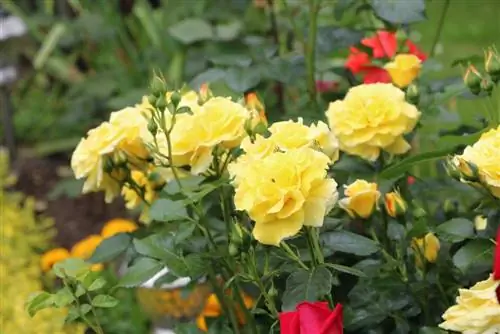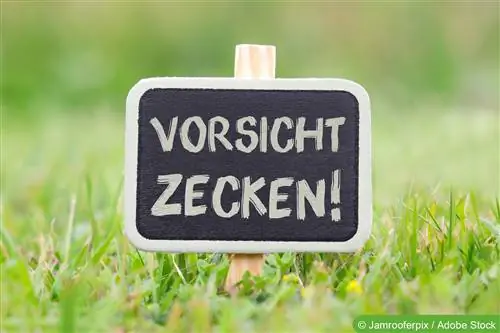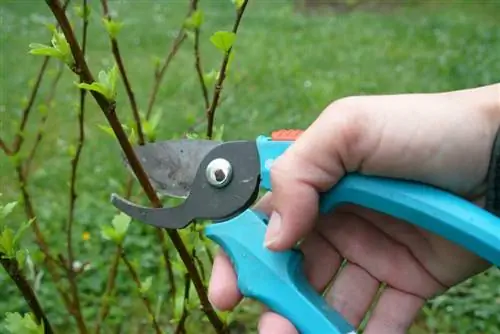- Author admin [email protected].
- Public 2023-12-17 03:39.
- Last modified 2025-01-24 12:45.
Shrubs and bushes in the garden serve as a privacy screen or as a green eye-catcher on a large meadow, as well as as a garden bed divider. A distinction is made here between evergreen, flowering or deciduous shrubs and bushes. Every hobby gardener who wants to cultivate new plants in the garden naturally wonders when the best time to plant them is.
Unfortunately, there is not just one answer to the question of the best time to plant shrubs and bushes. Because many factors play a role here. So it already depends on whether it is container goods, is the bush delivered in a pot, or does it just come from the garden center into the home garden as a root ball without a pot, or is it even bare-rooted. This determines whether these shrubs should be planted in spring or autumn. And the respective species or variety must also be taken into account here.
Ideal planting time

Basically, the best time to plant shrubs and bushes is between October and March, although the frosty days in winter should be avoided. However, no new bushes should be cultivated in the garden during the hot summer months, as it can be very dry during this time and it could be very difficult for the bushes to grow roots if they do not receive enough water. Of course, this doesn't have to be a reason not to plant trees in summer, but most gardening experts advise against this. But when it comes to the question of which shrubs should ideally be planted in autumn or spring, there are several answers that need to be considered:
- how is the shrub delivered from the nursery
- in the container
- with root ball
- nakedroot
- is the bush frost hardy
- does the plant need winter protection
- are these evergreen bushes
- are the selected shrubs deciduous
- are they early or late flowering plants
Tip:
If you buy a new shrub in a nursery or tree nursery in the fall, you can see from the attached labels whether it is a hardy, deciduous or evergreen shrub and then decide whether it is better for you Planting in autumn or spring is suitable.
Planting time autumn
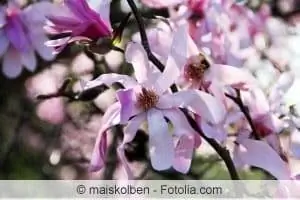
Many factors play a role in cultivating a shrub in the garden bed in the fall before frost. It is a great advantage, especially for bare-root bushes, if they are replanted before the first frost; the only requirement for this is, of course, that they are a winter-hardy species. In most tree nurseries, the bushes that are to be sold are removed from the beds in autumn and stored elsewhere. They are usually stored in cold storage or in bundles in trenches and the roots are only loosely covered. Since they have already been removed from the soil, this storage is not good for the plants in the long term. Therefore, bare-root shrubs should only be purchased in autumn, shortly after excavation, and planted directly. This gives the hobby gardener the guarantee that these plants were freshly removed from the soil in the spacious bed and have not yet suffered any damage. Other aspects should be taken into account when planting in autumn:
- Soil should still be pleasantly warm in autumn
- plant between mid-October and early December before frost
- Plants need less water than in spring
- therefore no need for frequent watering
- Shrubs with root balls can also be planted in autumn if they are a hardy variety
Tip:
If evergreen, frost-hardy deciduous trees or coniferous trees are planted bare-root or with soil balls in autumn, the only exception should be a time in September for these plants. These shrubs also evaporate water in winter and should therefore be well rooted before the first frost and are therefore better planted in late summer/early autumn.
Spring planting season
Spring is actually the ideal time to plant all frost-sensitive shrubs and bushes. However, you should avoid using bare-root plants when purchasing from the nursery and instead choose container goods or shrubs with root balls. Especially those who choose early-flowering shrubs will enjoy those grown in containers more in spring, because the roots are much better developed than those of bare-root plants. The frost-sensitive shrubs primarily include evergreen and deciduous trees such as:
- Hibiscus
- hydrangea
- Lavender
- Cherry Laurel
- Boxwood
- Rhododendron
Despite their sensitivity to frost, these bushes are usually planted in the garden bed and remain there over the winter. If they are planted in spring, they can root well throughout the warm summer. This means that these shrubs, which are not entirely frost-hardy, survive the first winter much better than if they were planted in autumn. If planted in spring, this should be done in March after the last frost or in April at the latest. However, it must be borne in mind that planting in spring involves more work for the hobby gardener over the summer months. In order for the bushes planted in the ground in spring to grow well, they must be watered regularly in dry and warm summers. These newly planted bushes usually do not tolerate prolonged drought, as can be the case with older plants.
Tip:
If you don't want so much work over the summer months, plant twice a year. In spring only the non-frost-hardy plants that need to be watered regularly in summer so that they are well established before winter, all others only in autumn.
Conclusion

It's not that difficult to find the right times to plant bushes and shrubs. All frost-sensitive and early-flowering shrubs should only be grown in containers, i.e. already cultivated in a pot, or planted in the garden bed in spring with a root ball that still has soil on it. Frost-resistant shrubs can also be planted in the fall before the first frost. The bare-rooted bushes available commercially should only be planted in autumn, otherwise they could be damaged if stored for a long time over the winter. Care should always be taken to ensure that these plants are hardy. Therefore, you should avoid purchasing bare-root plants in spring or autumn for shrubs that are not hardy. Container goods can be purchased all year round as the roots of the plants can develop well here. Plants with root balls can also be used all year round, as the roots also receive more protection from the existing soil.
Tips for container plants
Container plants, i.e. shrubs that have been grown in a planter and grow in it, can in principle be planted all year round. The prerequisite, of course, is that the ground is not frozen, i.e. frost-free.
General
In principle, you can almost always plant. It is only important to ensure that the shrub or shrubs do not dry out. In hot weather it is usually not enough to water just once a day. It is best to mulch and water at least in the morning and evening. If you have to move larger bushes in the summer, for example when moving, then protective measures must be taken. It is advisable to spray the leaves or needles with water. Shade nets can also speed up and facilitate growth in the new location. It is also important that the root ball is as large as possible and that the transplanting is well prepared.
Planting
A sufficiently large planting hole is important. It should be about twice the size of the plant ball. The bottom of the planting hole should be loosened with a digging fork. If the shrub is in the planting hole, soil is filled up. You use the excavated material, but mix in enough mature compost. The shrub receives initial fertilization in the spring. The top edge of the pot ball should be flush with the surrounding garden soil. The loose soil around the bush should be carefully tamped down. This means that the roots come into direct contact with the soil and can begin to form roots immediately. Don’t forget to water enough!

